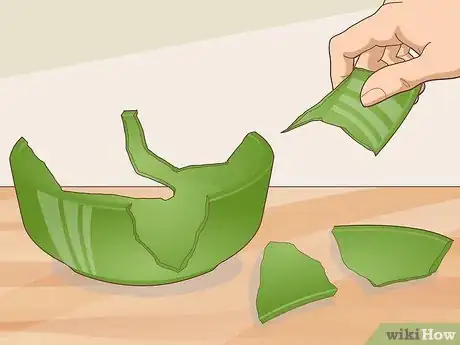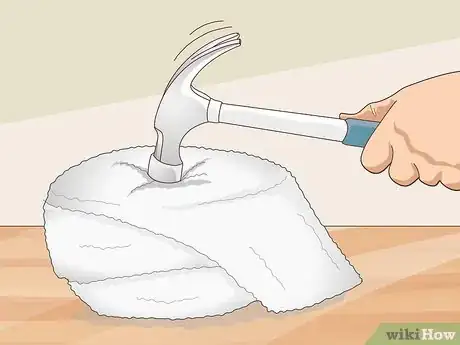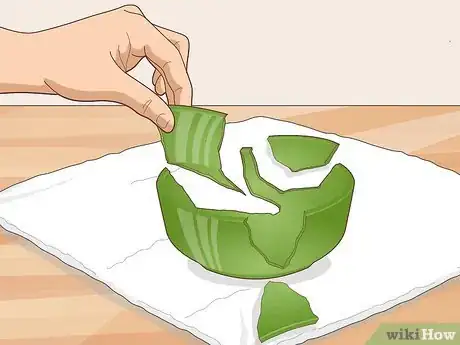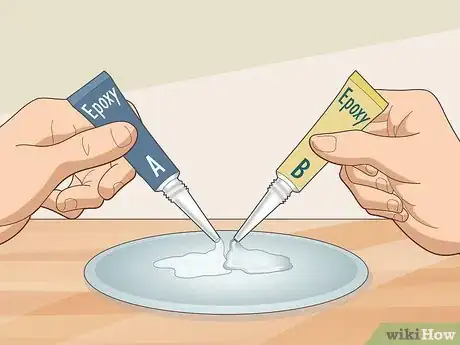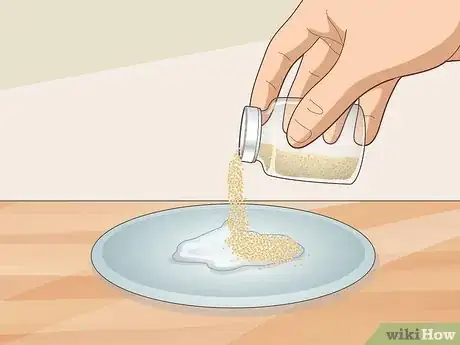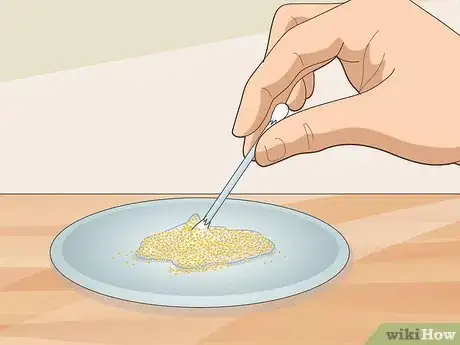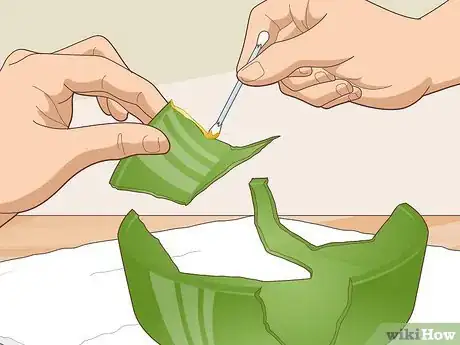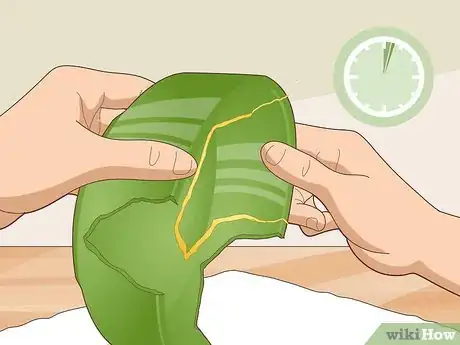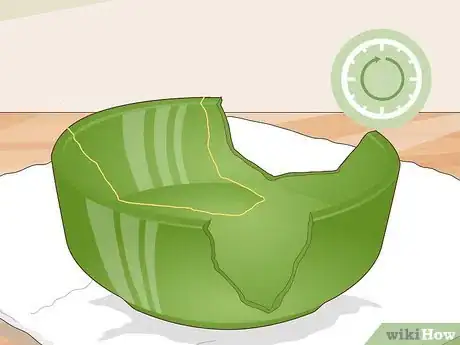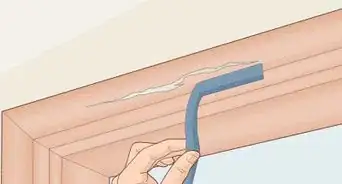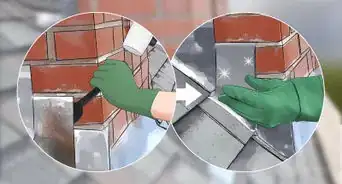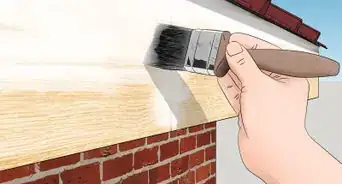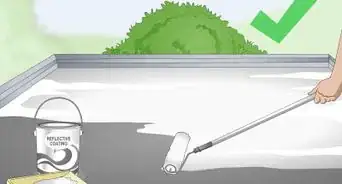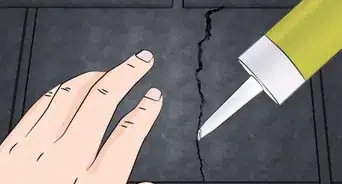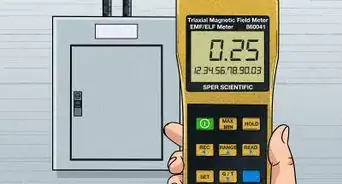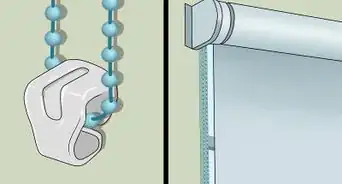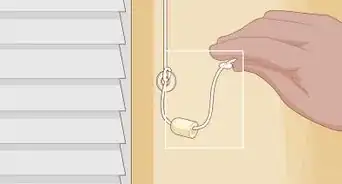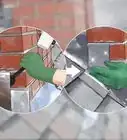This article was co-authored by wikiHow staff writer, Eric McClure. Eric McClure is an editing fellow at wikiHow where he has been editing, researching, and creating content since 2019. A former educator and poet, his work has appeared in Carcinogenic Poetry, Shot Glass Journal, Prairie Margins, and The Rusty Nail. His digital chapbook, The Internet, was also published in TL;DR Magazine. He was the winner of the Paul Carroll award for outstanding achievement in creative writing in 2014, and he was a featured reader at the Poetry Foundation’s Open Door Reading Series in 2015. Eric holds a BA in English from the University of Illinois at Chicago, and an MEd in secondary education from DePaul University.
There are 12 references cited in this article, which can be found at the bottom of the page.
This article has been viewed 30,955 times.
Learn more...
Kintsugi, which literally translates to “joined with gold,” is the ancient Japanese practice of mending broken ceramics with gold, silver, or platinum epoxy. The goal of a kintsugi repair is actually to highlight the cracks and damage with a bright metallic binding agent that draws attention to the damage. The art of kintsugi is closely related to the Japanese concept of wabi-sabi, which is the belief that accepting imperfection leads to enlightenment, beauty, and transcendence.[1] While you won’t be able to eat or drink out of an item you repair with the kintsugi method, the mended piece will make a stunning piece of art for your home. You can perform a kintsugi repair on any type of ceramic or porcelain.
Steps
Getting and Arranging Your Broken Pieces
-
1Perform this repair on an already-broken piece of ceramics if possible. You can perform a kintsugi repair on any porcelain or ceramic bowl, cup, vase, or plate. The next time a porcelain or ceramic item breaks in your home, set it aside for a kintsugi repair. While kintsugi-repaired items are not safe for food or drink, they do make phenomenal display pieces for you home.[2]
- The fewer pieces that break off of the object, the better. If the ceramic or porcelain item shattered into dozens of pieces, you cannot do a kintsugi repair.
- If this is your first attempt at kinstugi, use a broken ceramic item that isn’t particularly important to you.
Warning: Performing a kintsugi repair involves handling a broken object with sharp edges. While this isn’t dangerous to do if you have a steady hand and take your time, there is a risk that you may accidentally cut yourself. Be careful while completing your repair.
-
2Break a cheap ceramic item on purpose if you can’t wait to do a kinstugi repair. If you really want to perform a kintsugi repair, grab a cheap, unimportant ceramic or porcelain item. Put on some protective eyewear and thick gloves. Wrap the item 2-3 times in a thick towel and hold it 1–2 inches (2.5–5.1 cm) from the surface of the table. Gently tap the middle of the item with a hammer until it breaks and unfold the towel at your table.[3]
- While it certainly looks cool, kintsugi is not going to improve the value of your ceramic. Do not intentionally break an antique or expensive piece of pottery just to do the repair.
- If you do this, be extremely careful when you unfold the towel. Use the towel as the work surface for your repair to avoid losing any pieces or throwing tiny shards all over the place on your floor.
Advertisement -
3Set your pieces out in the order they fit together on a towel. Set your broken object out on a thick towel if you didn’t break it yourself. Without touching any of the broken edges, put each broken piece together by hand to make sure that you have every piece that you need. While you can fill in gaps that are smaller than 0.25 in (0.64 cm), you cannot do a kintsugi repair if there are bigger gaps in the ceramic. Spread your pieces out on the towel in the order that you will attach them.[4]
- Wear nitrile gloves if you want to avoid leaving fingerprints all over the object you’re repairing.
- This is especially important if your ceramic or porcelain is broken into more than 5 pieces. Once a piece is attached, you cannot undo it, so it’s incredibly important that you understand how your pieces will go together.
Mixing the Epoxy
-
1Pour a small amount 2-part epoxy into a disposable plastic cup or tray. Pick up a clear 2-part epoxy from your local craft store. Grab a small plastic container and squirt a quarter-sized dollop of both epoxies into it. One of these epoxies is a resin, while the other tube has a hardening agent. You are going to work in small sections, so you do not need to pour a lot of epoxy into the mixing container.[5]
- You can use a piece of wax paper or aluminum foil if you don’t have a good plastic receptacle for this.
- This stuff starts drying after 5-10 minutes. As a result, you must work in small sections by mixing a small bit of epoxy and mica powder, applying it, attaching a broken piece, and waiting. Any epoxy you can’t use immediately will be wasted, so don’t pour more than 1⁄4–3⁄4 teaspoon (1.2–3.7 mL) of epoxy out at a time.
Variation: There are kintsugi repair kits you can buy that come with everything you need for a beautiful repair. Order one online if you don’t feel like running around looking for 2-part epoxy and the other supplies.
-
2Add a dash of gold, silver, or platinum mica powder to the epoxy. Pick up some gold, silver, or platinum mica powder from a craft or makeup supply store. Sprinkle a dash of mica powder over the epoxy. You do not need a large amount of mica powder to dye the epoxy to a bright metallic shade, so start with a conservative pinch. You can always add more if it’s necessary![6]
- Kintsugi repairs are traditionally made with gold, silver, or platinum. You can use any color you’d like, but it won’t technically be a kintsugi repair if you don’t use a metallic color.
- Mica powder is made by grinding up mica, which is a natural mineral that comes in a variety of colors. It is often used in makeup and is perfectly safe to handle.
-
3Mix the mica and epoxy together until you reach your desired color. Grab a cotton swab or wooden mixing stick. Place the tip of the swab or stick in the epoxy and mica powder. Swirl the mixture around in a circular motion for 30-45 seconds until the powder mixes thoroughly into the epoxy. To lighten the shade, add a pea-sized dollop of epoxy. To darken the shade, add a light dash of mica powder.[7]
- You can tell when the epoxy and mica powder is thoroughly mixed when the color is uniform and no visible clumps of mica powder remain.
- You can use a paintbrush if you prefer, but you won’t be able to clean it after you’re done, so you may go through a lot of brushes if you’re repairing a lot of cracks.
- You will need a new cotton swab or mixing stick for every individual crack that you repair.
Attaching Your Cracked Pieces
-
1Apply the epoxy solution to the crack on the largest broken piece. Start with your biggest crack. Pick your first piece up and gently dab the epoxy solution into the exposed crack with your cotton swab or mixing stick. You do not need a lot epoxy, so gently drag the edge of your swab or stick across the surface to apply a thin layer of the epoxy. Either cover the cracked surface entirely in a thin layer, or add smaller, thicker lengths of epoxy along the center of the seam that you’re gluing.[8]
- Reload the swab or mixing stick whenever it looks like there isn’t any epoxy coming off of the tip.
- When you press the 2 pieces together, any thick globs of epoxy are just going to squeeze past the sides anyway, so there’s no real benefit to using a lot of the epoxy.
- If you’re using a thin layer of epoxy, spread the material over the exposed surface entirely. You can also simply load the middle of the seam up with a thicker layer of epoxy and let it spread naturally when you squeeze the pieces together.
- If you have a ton of epoxy left over, it’s a sign that you should mix less of it the next time you do this!
-
2Squeeze the first 2 pieces together for 2-3 minutes to let them dry. Put the mixing stick down and pick up the piece that you’re attaching in your dominant hand. Hold the piece with epoxy on it in your nondominant hand. Carefully line the 2 pieces up at the cracked edges. Gently squeeze the pieces together and make any minor adjustments immediately to line the pieces up perfectly. Hold the pieces together by applying light pressure for 2-3 minutes to give the epoxy time to bind.[9]
- While the epoxy mixture will take 12-24 hours to cure, the 2 pieces will stick together after a few minutes.
-
3Scrape the excess epoxy solution off with a razor blade. Set your glued piece down on the towel. Immediately grab a flat razor blade or small utility knife. Drag the blade gently over the surface of the seam you’ve just glued to scrape up any excess epoxy that’s sticking out past the surface of the porcelain or ceramic. This can be kind of tricky to do for round surfaces, so take your time and work in small sections to remove the excess epoxy.[10]
- The faster you can do this, the better. The epoxy becomes harder to scrape off after 10 minutes or so and it will have already been 3-5 minutes at this point.
- Wipe any particularly large globs of epoxy off with a dry towel.
- On a good kintsugi repair job, none of the epoxy and mica powder should be sticking out past the surface of the crack. The object should look like there are gold or silver veins running along the surface of the material. Some people like the look of the excess epoxy, though!
-
4Wait 12-24 hours for the epoxy to cure. The epoxy starts drying pretty quickly, but it typically takes 12-24 hours to completely dry. Attaching each broken piece requires a fair bit of pressure, so you have to wait for the first 2 pieces to dry entirely before you add any additional pieces.[11]
- If you don’t give the 2 pieces time to cure, the entire repair job may shatter in your hands when you apply pressure to the next piece you’re adding.
Tip: Read the label on your 2-part epoxy to see how long it takes to dry completely. Some epoxies take as little as 6 hours to cure, while others require 36 hours to air dry. Most epoxies need 12-24 hours of drying time, though.
-
5Continue this process until you have finished adding all of the broken pieces. Once your first 2 pieces are dry, repeat this entire process again. Mix more epoxy with a small amount of mica powder in a new plastic cup or tray. Apply the epoxy to a new crack and add your next piece. Hold the new piece against the dried portion for 2-3 minutes and wait another 12-24 hours for the epoxy to cure. Continue doing this until you finish the entire project![12]
- Always work in a way where you’re adding the piece that is adjacent to the previous section, closest to the piece you started with. If you ever have a choice (which may happen if you glue a middle piece), choose to add the piece that looks more stable.
- When you’re done, you’ll have a beautiful piece of ceramic art. You won’t be able to eat or drink out of it since the epoxy residue cannot be ingested, but it will make an absolutely stunning showpiece in your home!
- Don’t worry if your repair doesn’t look perfect. The entire premise of a kintsugi repair is that mistakes should be highlighted and valued!
Warnings
- Never touch a cracked ceramic edge with your fingers. Cracked ceramic edges can be incredibly sharp.⧼thumbs_response⧽
Things You’ll Need
- Two-part epoxy
- Mica powder
- Cotton swab or mixing stick
- Towel
- Hammer (optional)
- Protective eyewear (optional)
- Nitrile gloves (optional)
- Wax paper (optional)
References
- ↑ https://www.bbc.co.uk/programmes/articles/326qTYw26156P9k92v8zr3C/broken-a-pot-copy-the-japanese-and-fix-it-with-gold
- ↑ https://www.thisiscolossal.com/2014/05/kintsugi-the-art-of-broken-pieces/
- ↑ https://www.artsy.net/article/artsy-editorial-centuries-old-japanese-tradition-mending-broken-ceramics-gold
- ↑ https://youtu.be/RqWyKFZbPzI?t=227
- ↑ https://youtu.be/RqWyKFZbPzI?t=114
- ↑ https://youtu.be/CgVICaSBXCQ?t=141
- ↑ https://youtu.be/RqWyKFZbPzI?t=239
- ↑ https://youtu.be/NqBI7RcsKAc?t=322
- ↑ https://youtu.be/RqWyKFZbPzI?t=287
